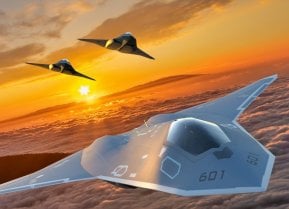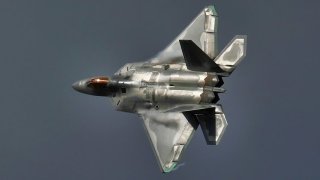GOAT: The F-22A Raptor Is the 'Michael Jordan' of Fighter Planes
The F-22A Raptor, widely regarded as the most advanced air superiority fighter, was prematurely canceled due to high costs and the 2008 financial crisis.
Summary and 4 Key Points: The F-22A Raptor, widely regarded as the most advanced air superiority fighter, was prematurely canceled due to high costs and the 2008 financial crisis.
-Originally intended to be exclusive to the U.S. Air Force, the Raptor's production was limited to just 186 units, far short of the 750 initially planned.
-The decision not to share the F-22 with allies, unlike the F-35 program, contributed to its high costs and eventual cancellation.
-Today, the limited number of F-22s poses a challenge in potential major conflicts, highlighting the importance of cost-sharing and international collaboration in future weapons development.
F-22 Raptor: The Advanced Fighter America Needed But Couldn't Afford
The F-22A Raptor is probably the most advanced air superiority fighter in existence today. It is the Michael Jordan of fifth-generation warplanes. An incredible avionics package, a sleek design that not only enhances its stealth capabilities but adds a “wow” factor that few other modern planes possess. It’s also a flying computer chip with an astounding suite of technological components that both ensure the plane will likely win in any dogfight it engages in and keeps the pilot of the bird alive and fighting longer than other aircraft will.
Even in the fifth-generation warplane family, the Raptor is peerless.
Despite this, the F-22A Raptor was never allowed to fulfill the basic expectations of her designers as well as the United States Air Force. In 2009, as fallout from the 2008 Financial Crisis rocked Washington, D.C., the Barack Obama Administration decided to cancel the production line for the F-22. This was at least a decade premature.
Given the sophisticated—and expensive—nature of the Raptor, it was already over-budget and under-produced by the time that former President Obama scrapped the warbird’s production line.
F-22: It's Always Easier to Destroy Than to Build
And, as the late US Army General Ray Odierno (ret) once quipped in a congressional hearing I attended, “I can dismantle whichever units you [Congress] want me to, but good luck standing them back up again when we need them for a fight.”
This notion applies even more to the highly complex F-22A Raptor.
Once the production line was severed, the human capital was dispersed, the supply chain was broken, and the capability to build more parts and airframes evaporated far quicker than it took to stand up the production line.
Thus, the Air Force’s original goal of having 750 F-22A Raptors was killed before it could be born. The USAF got 186 birds, with the final one being delivered in 2012. Last year, in fact, the oldest units that were among the first to be deployed were up for retirement!
More than anything, even before the 2008 Recession crushed America’s finances, the Raptor was simply far too expensive. What made the F-22A Raptor program so costly, on top of its next-level technology, was the fact that there was no burden sharing done with allied nations.
A decision was made early in the development of the program that the F-22’s systems were so advanced and the military technology in the planes was so unique, that to share it with other countries—allies—would risk undermining America’s technological dominance. So, the plane was kept exclusive to the United States military. Certainly, there was a legitimate fear, especially considering how unreliable even long-time allies, like Turkey, have become over the last 20 years.
Why the US Didn’t Share the F-22 Like It Shares the F-35 with Allies
Yet, making the F-22 available for export to America’s foreign allies, as the Pentagon did with America’s other fifth-generation warplane, the F-35 Lightning II, would have likely allowed for a massive, rapid reduction in the costs of the F-22 program. That reduction in cost would have further likely led to the survival of the program during the dark financial times of the 2008-2009 financial crisis.
By every measure, the F-22A Raptor is the warplane America needs now more than ever. As near peer rivals arise to challenge the United States across the arc of Eurasia, multiple war games conducted by the US military have shown that the introduction of F-22 Raptors tends to tip the balance of any engagement between near peer rival air forces in America’s favor.
But there are simply not enough Raptors to last a major power conflict.
Because of their limited number and the costs involved with restarting their production line, what the Air Force has is all it is going to get—and if we start losing F-22 birds in combat, there won’t be many replacements on hand, meaning Washington will want to keep those units in reserve.
The F-35, meanwhile, is now a cheaper alternative to the F-22. Yet, it still does not hold a candle to the air superiority capacities that the F-22 brings to any dogfight. It was only the innovative cost-saving measures of distributing production and exporting the F-35 to American allies that allowed for the F-35 to survive the devastating age of defense budget sequestration. What’s more, the F-35 was a joint strike project between the Air Force, Navy, and Marine Corps.
The F-35 Belonged to the Air Force, Navy, and Marines. The F-22 was Only for the USAF
On top of the foreign funding that the program received, the cost was also shared among three of the branches of the US military. The F-22, meanwhile, was exclusively an Air Force project. While the Navy expressed interest in a carrier-based variant of the F-22, the project never went beyond the drawing board.
Interoperability, burden-sharing, and cost-saving production methods is likely the only way that future combat systems will be developed, as the defense budget gets far too big for its own good. In an era of constrained budgets and contested environments globally, the F-35 development model is the better way to produce future weapons systems.
Author Experience and Expertise: Brandon J. Weichert
Brandon J. Weichert, a National Interest national security analyst, is a former Congressional staffer and geopolitical analyst who is a contributor at The Washington Times, the Asia Times, and The-Pipeline. He is the author of Winning Space: How America Remains a Superpower, Biohacked: China’s Race to Control Life, and The Shadow War: Iran’s Quest for Supremacy. His next book, A Disaster of Our Own Making: How the West Lost Ukraine, is due October 22 from Encounter Books. Weichert can be followed via Twitter @WeTheBrandon.
All images are Creative Commons or Shutterstock.
From the Vault
Russia Freaked Out: Why the U.S. Navy 'Unretired' the Iowa-Class Battleships
Battleship vs. Battlecruiser: Iowa-Class vs. Russia's Kirov-Class (Who Wins?)


